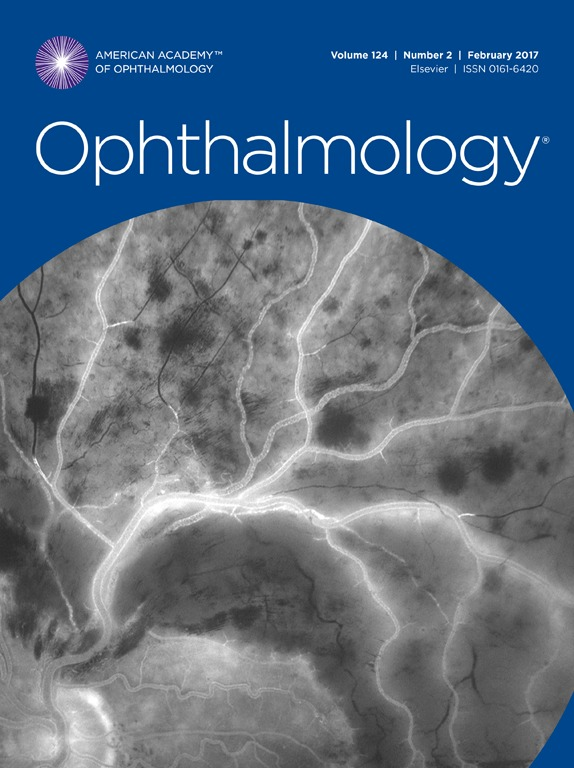角膜交联疗法治疗角膜炎的疗效预测能力评估:随机临床试验。
IF 13.1
1区 医学
Q1 OPHTHALMOLOGY
引用次数: 0
摘要
目的:验证治疗成像生物标志物在评估角膜交联术(CXL)平滑最大角膜指数(Kmax)方面的能力:前瞻性、随机、多中心、掩蔽临床试验(NCT05457647):干预:对参与者进行分层,分别采用上皮-关闭(epi-off;25 眼)和上皮-开启(epi-on;25 眼)CXL 方案,使用包含治疗软件模块的 UV-A 医疗设备。该设备使用受控紫外线-A 光进行 CXL,并实时估算角膜核黄素浓度(核黄素评分)和评估治疗效果(治疗评分)。在外延-关闭和外延-开启方案中,将 0.22% 核黄素制剂分别涂在角膜上 15 分钟和 20 分钟。所有眼睛均接受 9 分钟 10 mW/cm2 的紫外线-A 照射:主要结果指标是通过测量治疗成像生物标志物的准确性(正确分类眼睛的比例)和精确性(阳性预测值)来验证治疗成像生物标志物的综合使用,以正确分类眼睛并积极预测 CXL 后 1 年的 Kmax 平整度。其他结果测量指标包括 CXL 一年后 Kmax、内皮细胞密度、未矫正和矫正远视力、显性球面等效屈光度和中央角膜厚度的变化:结果:联合使用治疗成像生物标志物预测 1 年后 Kmax 值变平超过 0.1 屈光度 (D) 的眼睛的准确率和精确率分别为 91% 和 95%。Kmax值明显变平,中位数为-1.3 D(IQR:-2.11, -0.49 D;P <0.001);未矫正和矫正远视力均提高,中位数为-0.1 LogMAR(IQR:-0.3, 0.0 LogMAR;P <0.001,IQR:-0.2, 0.0 LogMAR;P <0.001)。术后一年,内皮细胞密度(P = 0.33)和角膜中央厚度(P = 0.07)无明显变化:该研究证明了将治疗技术整合到 UV-A 医疗设备中,通过外延-关闭和外延-开启 CXL 方案对角膜病进行精确和预测性治疗的有效性。角膜中核黄素的浓度及其紫外线-A 光介导的光激活作用是决定 CXL 治疗效果的主要因素。本文章由计算机程序翻译,如有差异,请以英文原文为准。
Assessment of the Predictive Ability of Theranostics for Corneal Cross-linking in Treating Keratoconus
Purpose
To validate the ability of theranostic imaging biomarkers in assessing corneal cross-linking (CXL) efficacy in flattening the maximum keratometry (Kmax) index.
Design
Prospective, randomized, multicenter, masked clinical trial (ClinicalTrails.gov identifier, NCT05457647).
Participants
Fifty patients with progressive keratoconus.
Intervention
Participants were stratified to undergo epithelium-off (25 eyes) and epithelium-on (25 eyes) CXL protocols using an ultraviolet A (UV-A) medical device with theranostic software. The device controlled UV-A light both for performing CXL and assessing the corneal riboflavin concentration (riboflavin score) and treatment effect (theranostic score). A 0.22% riboflavin formulation was applied onto the cornea for 15 minutes and 20 minutes in epithelium-off and epithelium-on protocols, respectively. All eyes underwent 9 minutes of UV-A irradiance at 10 mW/cm2.
Main Outcome Measures
The primary outcome measure was validation of the combined use of theranostic imaging biomarkers through measurement of their accuracy (proportion of correctly classified eyes) and precision (positive predictive value) to classify eyes correctly and predict a Kmax flattening at 1 year after CXL. Other outcome measures included change in Kmax, endothelial cell density, uncorrected and corrected distance visual acuity, manifest spherical equivalent refraction and central corneal thickness 1 year after CXL.
Results
Accuracy and precision of the theranostic imaging biomarkers in predicting eyes that had >0.1 diopter (D) of Kmax flattening at 1 year were 91% and 95%, respectively. The Kmax value significantly flattened by a median of –1.3 D (IQR, –2.11 to –0.49 D; P < 0.001); both the uncorrected and corrected distance visual acuity improved by a median of –0.1 logarithm of the minimum angle of resolution (logMAR; IQR, –0.3 to 0.0 logMAR [P < 0.001] and –0.2 to 0.0 logMAR [P < 0.001], respectively). No significant changes in endothelial cell density (P = 0.33) or central corneal thickness (P = 0.07) were noted 1 year after surgery.
Conclusions
The study demonstrated the efficacy of integrating theranostics in a UV-A medical device for the precise and predictive treatment of keratoconus with epithelium-off and epithelium-on CXL protocols. Concentration of riboflavin and its UV-A light mediated photoactivation in the cornea are the primary factors determining CXL efficacy.
Financial Disclosure(s)
Proprietary or commercial disclosure may be found in the Footnotes and Disclosures at the end of this article.
求助全文
通过发布文献求助,成功后即可免费获取论文全文。
去求助
来源期刊

Ophthalmology
医学-眼科学
CiteScore
22.30
自引率
3.60%
发文量
412
审稿时长
18 days
期刊介绍:
The journal Ophthalmology, from the American Academy of Ophthalmology, contributes to society by publishing research in clinical and basic science related to vision.It upholds excellence through unbiased peer-review, fostering innovation, promoting discovery, and encouraging lifelong learning.
 求助内容:
求助内容: 应助结果提醒方式:
应助结果提醒方式:


